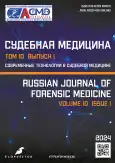Роль виртуальной реальности в совершенствовании судебной экспертизы по делам о нарушении правил охраны труда: научный обзор
- Авторы: Касенова С.О.1, Воеводкин Д.В.1
-
Учреждения:
- Академия правоохранительных органов при Генеральной прокуратуре Республики Казахстан
- Выпуск: Том 10, № 1 (2024)
- Страницы: 99-112
- Раздел: Научные обзоры
- URL: https://journals.rcsi.science/2411-8729/article/view/254431
- DOI: https://doi.org/10.17816/fm16105
- ID: 254431
Цитировать
Аннотация
В статье рассматриваются перспективы внедрения инновационных технологий в виде виртуальной и дополненной реальности при проведении судебных экспертиз в контексте исследования отдельных категорий уголовных дел, в частности о нарушениях правил охраны труда; раскрыты проблемные аспекты при проведении осмотров места происшествия в труднодоступных местностях с возможными рисками для людей.
На основе обобщения научных трудов и практического опыта зарубежных стран проведён анализ в области применения новшеств научно-технического прогресса в судебных экспертизах. В результате предложен алгоритм проведения судебной экспертизы в области охраны труда с использованием технологии виртуальной реальности, а также применения его в дальнейшем в судебных процессах. Предложенный алгоритм может служить основой для разработки более эффективных и безопасных методов проведения судебных экспертиз в условиях виртуальной реальности.
Развитие детальных трёхмерных моделей телесных повреждений, симулирующих реальные сценарии происшествий, позволит достичь более точной и объективной оценки повреждений. Кроме того, использование технологии виртуальной реальности в сравнении с традиционной экспертизой обеспечит высокую точность измерений, охват всего объекта исследования; значительно сократит время работы, а также сохранит всю полученную информацию в первозданном состоянии, что является отличной возможностью для воссоздания места происшествия в режиме реального времени.
Отмечается, что внедрение виртуальной реальности в судебную экспертизу по делам о нарушении правил охраны труда будет способствовать эффективности, объективности, полноте и достоверности не только заключений судебных экспертиз, но и судопроизводства в целом. Кроме того, данное направление развития технологий представляет значительные преимущества для судебной системы, способствуя как сокращению времени, так и справедливому судебному разбирательству по делам в области охраны труда или иных категорий уголовных дел.
Полный текст
Открыть статью на сайте журналаОб авторах
Самал Омарбековна Касенова
Академия правоохранительных органов при Генеральной прокуратуре Республики Казахстан
Автор, ответственный за переписку.
Email: samalkassenova122@gmail.com
ORCID iD: 0000-0003-3812-9275
SPIN-код: 1031-4186
Казахстан, Косшы
Денис Викторович Воеводкин
Академия правоохранительных органов при Генеральной прокуратуре Республики Казахстан
Email: voevodkin.denis@gmail.com
ORCID iD: 0000-0002-1763-1808
SPIN-код: 5512-0338
Казахстан, Косшы
Список литературы
- Кокин А.В. 3D-оружие и перспективы его криминалистического исследования // Теория и практика судебной экспертизы. 2017. Т. 12, № 2. С. 34-41. EDN: ZBMLEB doi: 10.30764/18192785-2017-12-2-34-41
- Воеводкин Д.В., Рустемова Г.Р., Бегалиев Е.Н., и др. К вопросу выявления поддельных заключений судебно-медицинских экспертиз посредством применения технологии искусственного интеллекта по опыту Республики Казахстан: научный обзор // Судебная медицина. 2023. Т. 9, № 3. С. 287-298. EDN: EFNJIE doi: 10.17816/fm8270
- Cornet L., van Gelder J.L. Virtual reality: A use case for criminal justice practice // Psychology. Crime and Law. 2020. Vol. 26, N 4. P. 1-17. doi: 10.1080/1068316X.2019.1708357
- Bailenson J. Experience on demand: What virtual reality is, how it works, and what it can do. New York: Norton and Company, Inc., 2018. 304 p.
- Солодкина Е.А. К определению понятия «виртуальная реальность» // Вестник Российского университета дружбы народов. Серия: Философия. 2004. № 1. С. 189-196. EDN: IIZFPN
- Wiederhold B.K., Jang D.P., Kim S.I., Wiederhold M.D. Physiological monitoring as an objective tool in virtual reality therapy // Cyberpsychol Behav. 2002. Vol. 5, N 1. P. 77-82. doi: 10.1089/109493102753685908
- Riva G., Mantovani F., Capideville C.S., et al. Affective interactions using virtual reality: The link between presence and emotions // Cyberpsychol Behav. 2007. Vol. 10, N 1. P. 45-56. doi: 10.1089/cpb.2006.9993
- North M.M., North S.M. A comparative study of sense of presence of virtual reality and immersive environments // Australasian J Information Systems. 2016. Vol. 20. P. 1-15. doi: 10.3127/ajis.v20i0.1168
- Lin Q., Xu Z., Li B., et al. Immersive virtual reality for visualization of abdominal CT // Proc SPIE Int Soc Opt Eng. 2013. Vol. 8673. doi: 10.1117/12.2008050
- González B.S., Martínez L., Cerdà M., et al. Assessing practical skills in cardiopulmonary resuscitation: Discrepancy between standard visual evaluation and a mechanical feedback device // Medicine (Baltimore). 2017. Vol. 96, N 13. P. e6515. doi: 10.1097/MD.0000000000006515
- Пискунова Е.В. 2014.04.042. Использование 3D-технологий в криминалистике и судебной экспертизе (реферативный обзор) // Социальные и гуманитарные науки. Отечественная и зарубежная литература. Серия 4: Государство и право. 2014. № 4. С. 153-164. EDN: VZZYTP
- Van Gelder J.L., Otte M., Luciano E.C. Using virtual reality in criminological research // Crime Science. 2014. Vol. 3, N 10. P. 1-12. doi: 10.1186/s40163-014-0010-5
- Poelman R., Akman O., Lukosch S., Jonker P. As if being there: Mediated reality for crime scene investigation // Conference: CSCW '12 Computer Supported Cooperative Work, Seattle, WA, USA, February 11-15, 2012. doi: 10.1145/2145204.2145394
- Barazzetti L., Sala R., Scaioni M., Cattaneo C. 3D scanning and imaging for quick documentation of crime and accident scenes // Proceedings of SPIE: The International Society for Optical Engineering. 2012. Vol. 8359. P. 835910/1-13. doi: 10.1117/12.920728
- Jamieson A. A rational approach to the principles and practice of crime scene investigation: I. Principles // Sci Justice. 2004. Vol. 44, N 1. P. 3-7. doi: 10.1016/S1355-0306(04)71678-0
- Rattfält S. Brottsplatsdokumentationmed laserskanneren sammanfattningav området. 2015.
- Sieberth T., Dobay A., Affolter R., Ebert L.C. Applying virtual reality in forensics: A virtual scene walkthrough // Forensic Sci Med Pathol. 2019. Vol. 15, N 1. P. 41-47. EDN: BRYLIP doi: 10.1007/s12024-018-0058-8
- Сотников А.М., Тычков А.Ю., Золотарев Р.В., и др. Использование AR и VR в медицине // Вестник Пензенского государственного университета. 2021. № 4. С. 112-116. EDN: TCJFWL
- Wang J., Li Z., Hu W., et al. Virtual reality and integrated crime scene scanning for immersive and heterogeneous crime scene reconstruction // Forensic Sci Int. 2019. Vol. 303. P. 109943. doi: 10.1016/j.forsciint.2019.109943
- Оракбаев А.Б., Курмангали Ж.К., Бегалиев Е.Н., и др. К вопросу об использовании результатов виртуальной аутопсии (виртопсии) в ходе расследования преступлений: научный обзор // Судебная медицина. 2023. Т. 9, № 2. С. 183-192. EDN: OEERGD doi: 10.17816/fm774
Дополнительные файлы










